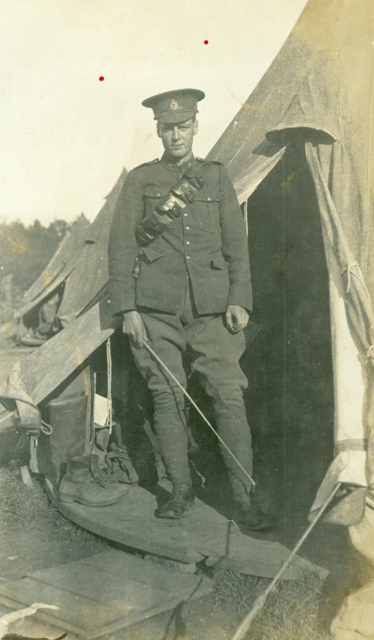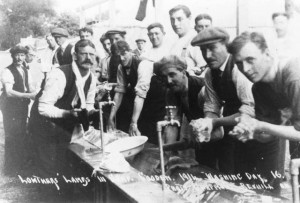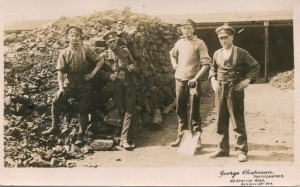
Colonel Claude William Henry Lowther (1872–June 1929), was the Conservative Member of Parliament for the Cumberland constituency of Eskdale and the owner of Herstmonceux Castle in Sussex.
He was well-known for being a very patriotic man – he was so patriotic that in the early days of the war he organized the men of Herstmonceux and district into a “Home Defence Company”, a sort of “Home Guard”, in readiness for any possible invasion. Following that success and with his patriotism stronger than ever, he went on to persuade the government to allow him to form a battalion of men raised from the area of the South Downs.
The 11th, 12th & 13th Battalions, 1st, 2nd, 3rd South Downs
In September 1914, he raised and equipped as part of the Royal Sussex Regiment, the 11th Battalion, known as the 1st South Downs. So many men came forward from all over the country, not just Sussex, that in that same month he was able to form another Battalion, the 12th Battalion (the 2nd Southdowns).
The reason why so many young men came forward was the growing feeling of patriotism within the country and according to the “Eastbourne Gazette” in 1914, his rousing appeal to all young men; –
“I call upon every man, with red blood in his veins, to join the second Southdown Battalion of the Royal Sussex Regiment. You will not be separated! Together (in your own county) you will train. Together you will fight. Together you will die if need be, but together, pray God, you may return.”
The call for brothers, relatives, townsfolk, and villagers to join up and serve together came to be known as the “Pals Battalions” and this idea had a great appeal to many young men eager to do their bit. No one at that time was aware of the tragic consequences of this idea – when a battle was lost with a high number of casualties, whole families might lose all their sons or villages and towns most of their men. It would eventually be realised and the practice stopped. In November 1914, Lowther once again roused enough men to form yet another Battalion – the 13th (3rd Southdowns). After this the three battalions became known collectively as “Lowther’s Lambs”.
Training at Cooden Camp
In September 1914 the Battalions, at first just the 11th and 12th, then later the 13th, were sent for training at a new Army Camp at Cooden, Bexhill. A description of this new camp was given in the “Bexhill Chronicle” on 26th September 1914 under the heading, “News and views of the camp – By our special Representative.”

Cooden Camp, it says, was built on a beautiful site right at the back of “Coulton Mount” (probably now “Coulton Heights”) on a little plateau. It goes on to say that:-
“…the camping ground could not have been better selected if it had been made on purpose. They have a glorious view of the full sweep of the Bay and the Channel and they are right in the middle of the prettiest bits of scenery in Sussex. It will give them always a pleasant memory of Bexhill.”
In July 1915, the three battalions came under the direct control of the War Office and were moved to a camp at Detling, near Maidstone, in Kent for more training but they were not there long before, on 29th September 1915, they were moved, this time to North Camp, Aldershot where they became part of the 116th Brigade, 39th Division. This division had been formed at Winchester, in August 1915, and was now concentrated at Witley Camp, in Surrey. The Lamb’s final move was to this camp to join the rest of the Division. All this time they were being given training in all aspects of warfare including trench warfare.
Fleurbaix and first contact with the enemy
On 4th March 1916 the Lowther’s Lamb’s marched out of Witley to East Milford railway station “to entrain at Milford for active service”. It took three trains to transport the battalions to Southampton where, on the same day they sailed in three ships to Le Havre. On 12th March they marched to Fleurbaix for instruction and further training, but instead of what they expected, on the following day they were heavily shelled and suffered their first casualties. Major, the Hon. Neville Lytton, Captain H. Tyler were wounded, while four other ranks were killed and nine wounded, one dying of his wounds.
The Battle of Boar’s Head
Worse was to come for Lowther’s Lambs, as the British and the French had been planning the “Somme Offensive” since almost the beginning of 1916 and had decided that in order to draw any attention away from where they planned to make that offensive, and therefore avoid the Germans reinforcing the area, a series of diversionary attacks would be made before, and during, the main battle. The British units selected for the attack were the 11th, 12th, and 13th Battalions of the Royal Sussex Regiment – Lowther’s Lambs. An additional problem was that very few of the officers and men had any experience of combat on the Western Front and they would be facing a well organized and determined enemy.
One of these attacks was planned on the German lines, opposite Richebourg L’Avoué, which included a salient known as “Boar’s Head”. This salient was of great importance to the Germans as it gave them a vantage point from which they could observe the Allies trenches and bombard them with mortars and rifle fire. On 30th June the men left their trenches and advanced through the smoke and half-light towards the German positions. The Southdowns led the attack and immediately came under heavy rifle and machine gun fire. In spite of this, some of them managed to fight their way through the German wire and occupy the front-line trenches which they held for almost four hours before they were forced back and had to return to their own lines while every inch of the way they were under fierce German counter attacks. In less than five hours the South Downs suffered approximately 1000 casualties, with over 360 of them being killed. In this battle Company Sergeant Major Nelson Victor Carter of the 12th Battalion, aged 29, and from Hailsham, was posthumously awarded the Victoria Cross for gallantry in the face of the enemy.
The Southdowns would go on to fight many more battles before the war was over but this they would never forget. The 12th Battalion was disbanded on 8th February 1918, and the men went, mainly, into the 11th and 13th Battalions.Both the 11th and 13th battalions continued to serve on the Western Front with 116th Brigade, 39th Division until the spring of 1918.
March 1918
By the spring of 1918, the Allies knew that the Germans would have to make a major attack somewhere along the front line but had no idea where that might be. The British reinforced their positions near the coast while the French did the same with their positions to the south of the British. These reinforcements however, failed to do anything about a weakness in the British lines to the west of Cambrai where their trench system was incomplete and many trenches were inadequate. Both the British and German commands were aware of this weakness but the British commander had few reserves left to call on if the Germans carried out an attack on the sector where the Fifth Army was stationed. German reconnaissance had made them also well aware of the weak defences in that area.

The German General, Ludendorff, on 21st March finally launched the offensive that the allies were certain had to come. In just five hours the Germans fired one million artillery shells at the British lines for a distance of 50 miles. The artillery bombardment was followed immediately, by an attack carried out by elite “Storm troopers” – the allies were outnumbered by three to one.
Following heavy losses in this German Offensive the 11th and 13th battalions were reduced to training cadres, where these by now experienced man would teach and train others. The 11th moved to Boulogne as part of the 25th Division on 30th June 1918, and then crossed to England. The 13th battalion personnel were used to train soldiers of the American Expeditionary Force before being finally disbanded on 14th August 1918.
Other articles about Lowthers Lambs

